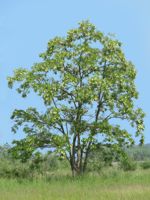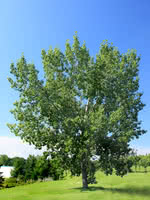Mon-Fri 9am - 5pm Mountain time
Balsam Poplar vs Black Locust
Robinia pseudoacacia
Populus balsamifera
Black Locust is an attractive tree. Its distinctive leaves are made of about a dozen bright green leaflets. It also notable for its fragrant white flowers, which smell of citrus.
Black Locust can grow in many situations, but prefers dry areas with lots of sun. It is robust and is an excellent choice for establishing shade in dry, open areas.
Important note: Much of the Black Locust is toxic to humans and livestock, including seeds, bark, and leaves.
Balsam Poplar is a hardy, fast-growing deciduous tree that is Native to Canada east of the Rockies.
We grow them in two variations. Sometimes they are a male clones, so they don't produce fluff. Other times, we grow them from seed, which will result in fluff. The detailed descriptions (see below) will tell you which is which.
Black Locust Quick Facts
Balsam Poplar Quick Facts
In row spacing: 2.4 - 3 m (8 - 10 ft)

